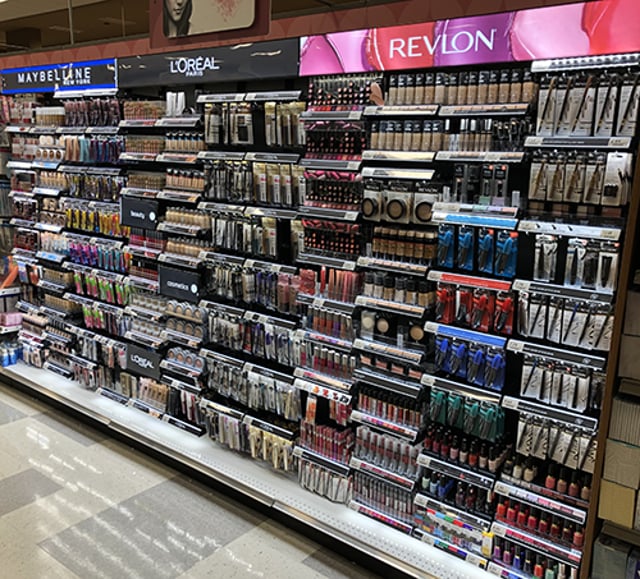Capitalizing on cosmetics in grocery
Simplifying cosmetic resets not only minimizes the disruption to the department, it saves costs. Innovative fixtures, proven processes, and advanced merchandising tools offer grocers efficiencies that will positively impact their bottom line.
When you think of grocery stores, cosmetics might not be the first product type that comes to mind. However, according to two resources who provide services to streamline cosmetic department sets and resets, their grocery channel sales are growing.
L&R Distributors is a New York-based national distributor servicing several retail channels including supermarkets. One of the key categories they offer is beauty/cosmetics in national, independent, and regional supermarket chains, currently supplying to over 10,000 store locations. Jim Athey, chief customer officer at L&R, said they are growing exponentially. Likewise, Larry Alper, sr. vice president of business development for Wisconsin-headquartered PM Plastics, a custom plastic injection molding and manufacturing company, said they, too, have seen a surge in the grocery segment.
[Read More: Delivering to consumer expectations]
For a department that demands updating semi-annually for new item additions in the Spring and Fall, the more quickly and efficiently that can be accomplished, the better. That’s where fixture solutions from PM Plastics and systems, processes, products, and services provided by L&R bring value.
PM Plastics offers the Universal Cosmetic Wall, which is designed to provide retailers more flexibility and control of their cosmetic department. In addition to mass market and chain drug stores that have implemented the Universal Cosmetic Wall, it has become widely adopted by grocery stores as well. Alper explained, “Rather than stores having to coordinate multiple deliveries of various parts and components from the brands, the Universal Cosmetic Wall includes these display elements. They are standardized so they can be applied to all brands and the result is a cohesive appearance throughout the department. HRG provides critical oversight to make sure everything from products to trays fit so installations are streamlined, simplified, and 100% planogram compliant.”
PM Plastics has worked with L&R on hundreds of cosmetic department installations across grocery and other channels. The goal is to provide the ultimate, consistent shopping experience for consumers.
[Read More: Consumer feedback is driving innovation in skin care]
Improving the in-store experience begins with refining the product assortment, and that starts with data and analytics. L&R uses their internal proprietary databases and the Repsly merchandising tool to buildproduct assortments based on data. Their field merchandising team uses the tool to document what the cosmetic set looked like when they arrived, write the product order, and pack out the previous order. They also use it to document what the set looks like after they have updated it which can be easily shared with the store’s headquarters, providing retailer partners real-time data. Any questions the merchandiser may have during implementation can be communicated to their supervisor through Repsly for a quick answer.
Removing that complexity from the process is where we can provide great value to grocers,” Athey said. By simplifying the overall set and reset process, costs are decreased for the retailers who benefit from a turnkey solution.
“We’re also looking at modifications to improve the shopping experience even further,” Athey continued. “We’re investigating technologies that will enhance the omnichannel experience, reduce shrink, offer virtual try-on, and extend the endless aisle. Working with companies like PM Plastics to bring these elements into the fixtures is the next innovation.”
[Read More: The burgeoning beauty supplement market]
Cosmetic items may be slower-turning SKUs in grocery, but they are also highly profitable, so worth putting thoughtful effort into. Plus, grocers don’t have to put special effort into getting customers into their store, just create a shopping experience that attracts current shoppers to the department.
According to the “2018 The Power of GM/HBC in Grocery” report from FMI and Acosta, “80% of U.S. households shop for HBC in grocery stores, yet 77% of their HBC spend happens in other channels.” The report goes on to state that, “if the grocery channel was to capture it’s fair share of HBC sales it would represent an incremental $29B.”
Curating the right cosmetic product assortment and improving in-store merchandising with accurate planograms and easy-to-implement fixtures is a starting point. With key systems in place, grocers can expect a positive impact on their bottom line – without taxing internal resources.
Megan Moyer is HRG’s corporate marketing manager. PM Plastics utilizes HRG’s fixture coordination services across retail channels. HRG stores fixture attribute data to validate that elements will fit at shelf or pinpoint the fixture that will accommodate them. HRG has worked with L&R to provide image and data product content for e-commerce.


